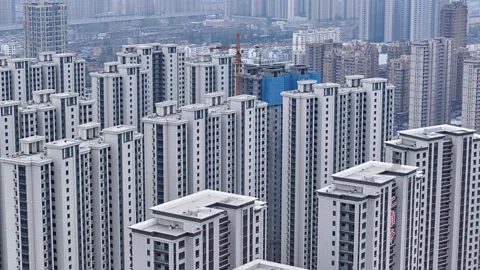
The environmental cost of China’s addiction to cement
[ad_1]
Features correspondent
 Getty images
Getty imagesThe use of concrete exploded to fuel China’s rise. Now the costs of this weighty material are being counted.
China’s cities are sinking – apparent victims of their own success. Large swathes of the country’s population now live in major cities that are subsiding at more than 3mm (0.1in) per year, according to a recent study. Some areas are sinking by more than 45mm (1.7in) each year, such as parts of Beijing. And by 2120, around a quarter of China’s coastal land will be beneath sea-level, the researchers predict.
While there are a number of reasons for the subsidence, the researchers have pointed to the rapid rate of urban development as among the culprits. The huge amounts of groundwater abstraction needed to support urban populations alongside the weight of the buildings and city infrastructure were singled out by the researchers as contributing to the sinking.
It follows similar research in New York City that found the enormous weight of the concrete, glass and steel – an estimated 762 million tonnes – in the city’s skyscrapers were contributing to subsidence of the land they sit upon.
Both studies have shone a light on some of the unexpected effects of urban development. But the Chinese research in particular has highlighted just how rapidly China’s cities have developed and the scale of urban expansion in the city.
We can turn to one material, above all others, that has supported this growth: concrete, the second most used substance on earth after water.
This frenetic rate of construction has required vast quantities of concrete’s core components of sand, gravel, water and cement. Today, China still accounts for just over half of the world’s total annual 4.1bn tonnes of cement production (52%) – followed by India (6.2%), the EU (5.3%) and the US (1.9%). Little of that cement produced in China is exported. In 2020 the country used an estimated 2.4 billion tonnes of cement, 23 times the amount used in the US in the same year.
China’s concrete boom is also slowing down, with both levels of consumption and production falling in recent years, at the same time investment in its real estate development has also declined. But its construction industry still dwarves that of any other country, with India’s level of cement use 10 times lower.
So what will be the legacy of China’s building bonanza? There are the offices, homes and factories from which its growing economy runs. But there are also the environmental costs.
 Getty images
Getty imagesChina’s concrete addiction is a relatively recent phenomenon. For millennia, timber was the nation’s main building material, says Chen Yichuan, a researcher of the history of concrete at University College London, in the UK. By the 19th Century, however, this resource was running out, especially in East China, where construction was most intense.
Imported timber and steel sufficed for a time. Then, when imports were cut off after the Communists took power in 1949, Chinese engineers and designers had to devise ways to build without these two materials. This “resulted in the preference for concrete we see today”, says Yichian.
The country’s cement production saw steady rapid growth from at least 1990 to 2015, says Edmund Downie, a climate and energy researcher at Princeton University. In 1998, around 536 million tons of cement were produced; by 2023, that number stood at 2.022 billion tons, according to data compiled by Robbie Andrew at The Centre for International Climate research (CICERO) in Norway.
But while concrete was once considered a sustainable material, avoiding the deforestation that led to floods, today it is a much more problematic resource.
When a mixture of limestone and clay is heated (typically using fossil fuels), carbon dioxide (CO2) is released as a by-product. Around 8% of human-caused global emissions thus come from the cement industry – which, if a nation, would put it third in the world, behind only China and the US.
Moreover, globally, these emissions are projected to continue increasing. By 2050, continuing urbanisation, particularly in developing nations, is expected to increase cement demand 12-33% above 2020 levels.
Concrete’s flooding threat
Even once it has been fixed in place as part of buildings and roads, concrete also continues to pose an environmental threat. Not only can urban sprawl result in habitat and biodiversity loss, poor planning and insufficient drainage have exacerbated floods in many parts of the world. When rainfall cannot quickly soak away, it can increase the risk of flash floods.
With 640 cities at risk of flooding, China is particularly susceptible to concrete’s power to amplify the dangers of heavy rainfall. In 2021, over 300 people in the inland city of Zhengzhou lost their lives to an extreme rainfall event.
But while China has suffered some of concrete’s most damaging effects, it is also taking action to address these threats.
Downie notes that between 2005-15, cement production was overhauled. Plants were forced to upgrade, stricter standards on pollution were introduced and output in northern regions was restricted during the winter months (when emissions from power production are generally higher). The result was falling pollution: while cement production increased 10-fold, particulate matter and carbon monoxide emissions from production declined.
 Getty Images
Getty ImagesCement’s nitrogen oxide emissions, which produce acid rain and smog have also been tackled in the past decade, with Beijing and other provinces tightening emissions limits and techniques introduced to improve the production process.
To tackle the linked climate and environmental challenges, the world’s concrete addiction must be further addressed. Yet, although there is still room for improvement, cement industry bodies are hopeful their member companies can accelerate the decarbonisation of the sector. And there are already some efforts at rehabilitating old quarry mines in China, notes Andrew Minson from the Global Cement and Concrete Association.
“I think China’s experience can help other developing countries think about how to take advantage of concrete’s wonderful advantages while mitigating its downsides,” says Downie. “I don’t think China will be the last nation to urbanise and industrialise with concrete so prominent – concrete is fundamental to modern building and infrastructure. So the world will have to find a way to make it in a low-carbon fashion.”
[ad_2]
Source link





